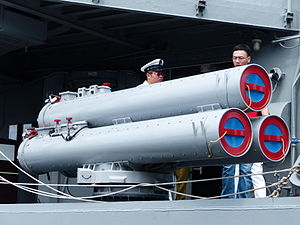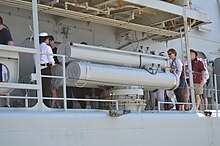
The RUR-5 ASROC is an all-weather, all sea-conditions anti-submarine missile system. Developed by the United States Navy in the 1950s, it was deployed in the 1960s, updated in the 1990s, and eventually installed on over 200 USN surface ships, specifically cruisers, destroyers, and frigates. The ASROC has been deployed on scores of warships of many other navies, including Canada, Germany, Italy, Japan, the Republic of China, Greece, Pakistan and others.

A cruiser is a type of warship. Modern cruisers are generally the largest ships in a fleet after aircraft carriers and amphibious assault ships, and can usually perform several roles.

In naval terminology, a destroyer is a fast, manoeuvrable, long-endurance warship intended to escort larger vessels in a fleet, convoy or battle group and defend them against powerful short range attackers. They were originally developed in 1885 by Fernando Villaamil for the Spanish Navy as a defense against torpedo boats, and by the time of the Russo-Japanese War in 1904, these "torpedo boat destroyers" (TBDs) were "large, swift, and powerfully armed torpedo boats designed to destroy other torpedo boats". Although the term "destroyer" had been used interchangeably with "TBD" and "torpedo boat destroyer" by navies since 1892, the term "torpedo boat destroyer" had been generally shortened to simply "destroyer" by nearly all navies by the First World War.

A warship or combatant ship is a naval ship that is built and primarily intended for naval warfare. Usually they belong to the armed forces of a state. As well as being armed, warships are designed to withstand damage and are usually faster and more maneuverable than merchant ships. Unlike a merchant ship, which carries cargo, a warship typically carries only weapons, ammunition and supplies for its crew. Warships usually belong to a navy, though they have also been operated by individuals, cooperatives and corporations.

The Fleet Rehabilitation and Modernization (FRAM) program of the United States Navy extended the lives of World War II-era destroyers by shifting their mission from a surface attack role to that of a submarine hunter. The FRAM program also covered cruisers, aircraft carriers, submarines, amphibious ships, and auxiliaries. The United States Coast Guard also used this term in the 1980s for the modernization of its Hamilton-class cutters.

The Spruance-class destroyer was developed by the United States to replace the many World War II–built Allen M. Sumner- and Gearing-class destroyers, and was the primary destroyer built for the U.S. Navy during the 1970s and 1980s. It was named in honor of United States Navy Admiral Raymond A. Spruance, who successfully led major naval battles in the Asiatic-Pacific Theater during World War II such as the Battle of Midway and the Battle of the Philippine Sea.
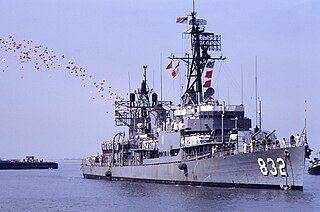
The Gearing class was a series of 98 destroyers built for the U.S. Navy during and shortly after World War II. The Gearing design was a minor modification of the Allen M. Sumner class, whereby the hull was lengthened by 14 ft (4.3 m) at amidships, which resulted in more fuel storage space and increased the operating range.
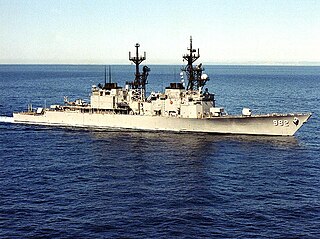
USS Fletcher (DD-992), the thirtieth Spruance-class destroyer, was part of the first major class of United States Navy surface ships to be powered by gas turbines. She was commissioned in July 1980 and was deployed mainly in the western and southern Pacific, but also voyaged to the Indian Ocean and Persian Gulf. She was the second ship in the U.S. Navy to bear this name but the first to be named after Admiral Frank Jack Fletcher. After her decommissioning in 2004, she was sunk in a torpedo test exercise in 2008.

A vertical launching system (VLS) is an advanced system for holding and firing missiles on mobile naval platforms, such as surface ships and submarines. Each vertical launch system consists of a number of cells, which can hold one or more missiles ready for firing. Typically, each cell can hold a number of different types of missiles, allowing the ship flexibility to load the best set for any given mission. Further, when new missiles are developed, they are typically fitted to the existing vertical launch systems of that nation, allowing existing ships to use new types of missiles without expensive rework. When the command is given, the missile flies straight up far enough to clear the cell and the ship, then turns on to the desired course.

The Mark 13 guided missile launching system (GMLS) is a single-arm missile launcher designed for use on frigates and other military vessels. Because of its distinctive single-armed design, the Mark 13 is often referred to as the "one-armed bandit".

The 127 mm (5")/54 caliber lightweight gun is a U.S. naval artillery gun mount consisting of a 127 mm (5 in) L54 Mark 19 gun on the Mark 45 mount. It was designed and built by United Defense, a company later acquired by BAE Systems Land & Armaments, which continued manufacture.

The 3"/50 caliber gun in United States naval gun terminology indicates the gun fired a projectile 3 inches (76 mm) in diameter, and the barrel was 50 calibers long. Different guns of this caliber were used by the U.S. Navy and U.S. Coast Guard from 1890 through the 1990s on a variety of combatant and transport ship classes.
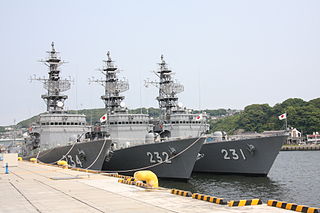
The Abukuma-class destroyer escort is the general-purpose destroyer escort of the Japan Maritime Self-Defense Force. It is the successor of the earlier Yūbari class.

The QF 4 inch Mk XVI gun was the standard British Commonwealth naval anti-aircraft and dual-purpose gun of World War II.
There have been several British 21-inch (533 mm) torpedoes used by the Royal Navy since their first development just before the First World War.

The Mark 41 Vertical Launching System is a shipborne missile canister launching system which provides a rapid-fire launch capability against hostile threats. The Vertical Launch System (VLS) concept was derived from work on the Aegis Combat System.

The Mark 26 Guided Missile Launching System (GMLS) was a United States Navy fully automated system that stows, handles, and launches a variety of missiles. The system supported RIM-66 Standard, RUR-5 ASROC, and potentially other weapons. The Mark 26 had the shortest reaction time and the fastest firing rate of any comparable dual arm shipboard launching system at the time. With only one man at the control console, a weapon can be selected, hoisted to the guide arm, and launched. Several mods provided magazine capabilities of 24 to 64 missiles.

JS Sawagiri (DD-157) is an Asagiri-class destroyer of the Japan Maritime Self-Defense Force.

Mark 63 Gun Fire Control System is a gun fire-control system made up of AN/SPG-34 radar tracker and the Mark 29 gun sight. They were usually equipped for the control of twin QF 4-inch naval gun Mk XVI and Mk.33 twin 3"/50 cal guns.
